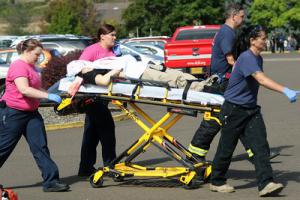GunsApplying public health models to gun violence
Research treats shootings like an epidemic — by applying public health models. Data indicate an individual’s odds of being a gunshot victim increase with exposure to gun violence. The work focuses not on mass shootings or isolated incidents of violence – rather, the researchers have worked to gather data on populations that face persistent threats of gun-related attacks and homicides, often connected to gang and drug activity.

Shooting victim being removed from the scene // Source: bu.edu
Yale University sociology professor Andrew Papachristos leads a team of researchers that collects information on an all-too-common occurrence in cities like Chicago, Boston, Newark, Cincinnati, and Oakland, California: gun violence.
The work focuses not on mass shootings or isolated incidents of violence; Papachristos’ team has worked to gather data on populations that face persistent threats of gun-related attacks and homicides, often connected to gang and drug activity.
Papachristos’ research shows they have properties similar to epidemics of disease. That means they affect particular communities disproportionately and multiply through exposure and can spill over into new areas after reaching a certain threshold.
Papachristos says, however, those same characteristics also provide some insight on how to treat gun violence. The NSF notes that with the support of the National Science Foundation (NSF) Social, Behavioral, and Economic Sciences directorate, he is gathering information aimed at helping policymakers do just that. Namely, research shows that solutions community-based economic and social approaches may be most effective at thwarting gun violence.
“Scientists, especially social scientists, have to address the hard questions,” he said. “This is one of them.”
Papachristos’ work seeks to understand the patterns of gunshot victimization, including that in Yale’s hometown of New Haven, Connecticut. His research team analyzed years’ worth of information on shootings and arrests in those cities. By doing so, they were able to identify the social networks of those charged as shooters, including incidents of “co-offending” involving multiple suspects and defendants, all associated with one another. Their results showed that a high concentration of shooting victims were actually connected within the same social networks as the accused shooters — and that, as an individual becomes exposed to more gunshot victims, his or her own chance of victimization increases.
During a recent visit to NSF, he described his research.
Q. What’s the focus of your current work?
A.My research looks at how gun violence is concentrated and moves among high-risk populations. The basic idea is to take the analogies about an “epidemic” of gun violence more seriously, applying what we know from public health and epidemiology to understand, quite literally, who gets shot. We can use that information not only to understand gun violence better, but to leverage it for intervention and prevention.
